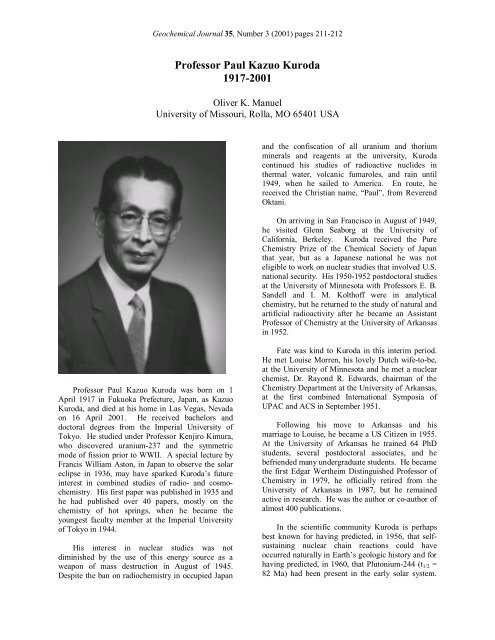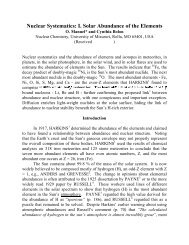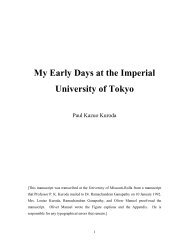Professor Paul Kazuo Kuroda 1917-2001 - Oliver Manuel
Professor Paul Kazuo Kuroda 1917-2001 - Oliver Manuel
Professor Paul Kazuo Kuroda 1917-2001 - Oliver Manuel
Create successful ePaper yourself
Turn your PDF publications into a flip-book with our unique Google optimized e-Paper software.
Geochemical Journal 35, Number 3 (<strong>2001</strong>) pages 211-212<br />
<strong>Professor</strong> <strong>Paul</strong> <strong>Kazuo</strong> <strong>Kuroda</strong><br />
<strong>1917</strong>-<strong>2001</strong><br />
<strong>Oliver</strong> K. <strong>Manuel</strong><br />
University of Missouri, Rolla, MO 65401 USA<br />
and the confiscation of all uranium and thorium<br />
minerals and reagents at the university, <strong>Kuroda</strong><br />
continued his studies of radioactive nuclides in<br />
thermal water, volcanic fumaroles, and rain until<br />
1949, when he sailed to America. En route, he<br />
received the Christian name, “<strong>Paul</strong>”, from Reverend<br />
Oktani.<br />
On arriving in San Francisco in August of 1949,<br />
he visited Glenn Seaborg at the University of<br />
California, Berkeley. <strong>Kuroda</strong> received the Pure<br />
Chemistry Prize of the Chemical Society of Japan<br />
that year, but as a Japanese national he was not<br />
eligible to work on nuclear studies that involved U.S.<br />
national security. His 1950-1952 postdoctoral studies<br />
at the University of Minnesota with <strong>Professor</strong>s E. B.<br />
Sandell and I. M. Kolthoff were in analytical<br />
chemistry, but he returned to the study of natural and<br />
artificial radioactivity after he became an Assistant<br />
<strong>Professor</strong> of Chemistry at the University of Arkansas<br />
in 1952.<br />
<strong>Professor</strong> <strong>Paul</strong> <strong>Kazuo</strong> <strong>Kuroda</strong> was born on 1<br />
April <strong>1917</strong> in Fukuoka Prefecture, Japan, as <strong>Kazuo</strong><br />
<strong>Kuroda</strong>, and died at his home in Las Vegas, Nevada<br />
on 16 April <strong>2001</strong>. He received bachelors and<br />
doctoral degrees from the Imperial University of<br />
Tokyo. He studied under <strong>Professor</strong> Kenjiro Kimura,<br />
who discovered uranium-237 and the symmetric<br />
mode of fission prior to WWII. A special lecture by<br />
Francis William Aston, in Japan to observe the solar<br />
eclipse in 1936, may have sparked <strong>Kuroda</strong>’s future<br />
interest in combined studies of radio- and cosmochemistry.<br />
His first paper was published in 1935 and<br />
he had published over 40 papers, mostly on the<br />
chemistry of hot springs, when he became the<br />
youngest faculty member at the Imperial University<br />
of Tokyo in 1944.<br />
His interest in nuclear studies was not<br />
diminished by the use of this energy source as a<br />
weapon of mass destruction in August of 1945.<br />
Despite the ban on radiochemistry in occupied Japan<br />
Fate was kind to <strong>Kuroda</strong> in this interim period.<br />
He met Louise Morren, his lovely Dutch wife-to-be,<br />
at the University of Minnesota and he met a nuclear<br />
chemist, Dr. Rayond R. Edwards, chairman of the<br />
Chemistry Department at the University of Arkansas,<br />
at the first combined International Symposia of<br />
UPAC and ACS in September 1951.<br />
Following his move to Arkansas and his<br />
marriage to Louise, he became a US Citizen in 1955.<br />
At the University of Arkansas he trained 64 PhD<br />
students, several postdoctoral associates, and he<br />
befriended many undergraduate students. He became<br />
the first Edgar Wertheim Distinguished <strong>Professor</strong> of<br />
Chemistry in 1979, he officially retired from the<br />
University of Arkansas in 1987, but he remained<br />
active in research. He was the author or co-author of<br />
almost 400 publications.<br />
In the scientific community <strong>Kuroda</strong> is perhaps<br />
best known for having predicted, in 1956, that selfsustaining<br />
nuclear chain reactions could have<br />
occurred naturally in Earth’s geologic history and for<br />
having predicted, in 1960, that Plutonium-244 (t 1/2 =<br />
82 Ma) had been present in the early solar system.
Geochemical Journal 35, Number 3 (<strong>2001</strong>) pages 211-212<br />
On 25 September 1972, the French Atomic Energy<br />
Commission announced the discovery of evidence<br />
that a natural nuclear reactor had occurred at Oklo in<br />
the Republic of Gabon, Africa, and the presence of<br />
excess xenon in the Pasamonte meteorite from the<br />
fission of 244 Pu was first detected in his laboratory at<br />
the University of Arkansas in 1965. Glenn Seaborg<br />
and Walter Lovelend selected both of <strong>Kuroda</strong>’s<br />
papers on these subjects as 2 of the 85 Benchmark<br />
Papers in Nuclear Chemistry (Benchmark Papers,<br />
Vol 5, Hutchison Ross Pub. Co, Stroudsburg, PA,<br />
1982).<br />
His students remember <strong>Kuroda</strong> for his deep<br />
personal commitment to the spirit of scientific<br />
inquiry, excellence in teaching, genius at seeing<br />
trends in data that others overlooked, love for his<br />
family, admiration and paternal kindness for his<br />
current and former students, and the sukiyaki dinners<br />
that he prepared when we were invited to his home.<br />
In addition to the Pure Chemistry Prize,<br />
<strong>Professor</strong> <strong>Kuroda</strong> received the University of<br />
Arkansas Distinguished Faculty Achievement Award<br />
(1963), the American Chemical Society Southwest<br />
Regional Award (1970), the American Chemical<br />
Society Southern Chemist Award (1973), the<br />
American Chemical Society Midwest Regional<br />
Award (1977), the American Chemical Society<br />
Nuclear Applications in Chemistry Award (1978),<br />
and the Shibata Prize of the Geochemical Society of<br />
Japan (1991). He was the Honor Initiate of Alpha<br />
Chi Sigma Fraternity at its Forty third Biennial<br />
Conclave in 1996.<br />
Potentially important scientific findings by<br />
<strong>Kuroda</strong> that have not yet received acclaim include<br />
reports that a) the 244 Pu/ 136 Xe ages of lunar samples<br />
and meteorites indicate formation of the solar system<br />
started 5.1 Ga ago, soon after the explosion of a<br />
supernova, and b) the breakup of meteorite parent<br />
bodies occurred 4.55 Ga ago, the age generally<br />
assumed for the solar system in attempts to interpret<br />
experimental data of older lead/lead and K/Ar ages.<br />
These findings are summarized in the recently<br />
published Proceedings of the Symposium that Glenn<br />
Seaborg organized on the Origin of Elements in the<br />
Solar System: Implications of Post-1957<br />
Observations. See http://www.wkap.nl/book.htm/0-<br />
306-46562-0 for information on this book, a list of<br />
contributors, and the Table of Contents.





